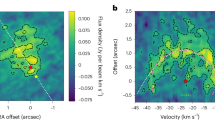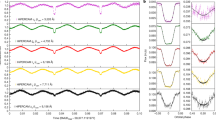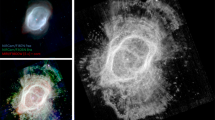Abstract
In 1981, the idea of a superwind that ends the life of cool giant stars was proposed1. Extreme oxygen-rich giants, OH/IR stars, develop superwinds with the highest mass-loss rates known so far, up to a few 10−4 solar masses (M⊙) per year2,3,4,5,6,7,8,9,10,11,12, informing our understanding of the maximum mass-loss rate achieved during the asymptotic giant branch (AGB) phase. A conundrum arises whereby the observationally determined duration of the superwind phase is too short for these stars to lose enough mass to become white dwarfs2,3,4,6,8,9,10. Here we report on the detection of spiral structures around two cornerstone extreme OH/IR stars, OH 26.5 + 0.6 and OH 30.1 − 0.7, thereby identifying them as wide binary systems. Hydrodynamic simulations show that the companion’s gravitational attraction creates an equatorial density enhancement mimicking a short, extreme superwind phase, thereby solving the decades-old conundrum. This discovery restricts the maximum mass-loss rate of AGB stars to around the single-scattering radiation pressure limit of a few 10−5 M⊙ yr−1. This has crucial implications for nucleosynthetic yields, planet survival and the wind-driving mechanism.
This is a preview of subscription content, access via your institution
Access options
Access Nature and 54 other Nature Portfolio journals
Get Nature+, our best-value online-access subscription
$29.99 / 30 days
cancel any time
Subscribe to this journal
Receive 12 digital issues and online access to articles
$119.00 per year
only $9.92 per issue
Buy this article
- Purchase on Springer Link
- Instant access to full article PDF
Prices may be subject to local taxes which are calculated during checkout




Similar content being viewed by others
Code availability
Figures 1–3, and Supplementary Figs. 1 and 2 were made using CASA35. Supplementary Fig. 3 was made using a simple Python script that can be distributed upon request. Supplementary Fig. 4 is based on ballistic trajectory calculations by one of the authors46 solving the equation of motion using a classical fourth-order Runge–Kutta scheme. The code is available for collaboration with I.E.M. upon reasonable request.
Data availability
The ALMA data from proposals 2015.1.00054.S, 2016.1.00005.S and 2016.2.00088.S can be retrieved from the ALMA data archive at http://almascience.eso.org/aq/. The data that support the plots within this paper and other findings of this study are available from the corresponding author upon reasonable request.
Change history
19 March 2019
In the version of this Letter originally published, the caption of Fig. 2 incorrectly said J = 3–2; it should have said J = 2–1. This has now been corrected.
References
Renzini, A. in Physical Processes in Red Giants (eds Iben, I. Jr & Renzini, A.) Astrophysics and Space Science Library Series, Vol. 88, 431–446 (D. Reidel Publishing, Dordrecht, 1981).
Heske, A., Forveille, T., Omont, A., van der Veen, W. E. C. J. & Habing, H. J. Deficiency of CO emission from massive envelopes around cool OH/IR stars. Astron. Astrophys. 239, 173–185 (1990).
Delfosse, X., Kahane, C. & Forveille, T. Superwind in evolved OH/IR stars. Astron. Astrophys. 320, 249–256 (1997).
Chesneau, O. et al. The mid-IR spatially resolved environment of OH 26.5 + 0.6 at maximum luminosity. Astron. Astrophys. 435, 563–574 (2005).
van Loon, J. T., Cioni, M.-R. L., Zijlstra, A. A. & Loup, C. An empirical formula for the mass-loss rates of dust-enshrouded red supergiants and oxygen-rich asymptotic giant branch stars. Astron. Astrophys. 438, 273–289 (2005).
Justtanont, K., Olofsson, G., Dijkstra, C. & Meyer, A. W. Near-infrared observations of water-ice in OH/IR stars. Astron. Astrophys. 450, 1051–1059 (2006).
Groenewegen, M. A. T., Sloan, G. C., Soszyński, I. & Petersen, E. A. Luminosities and mass-loss rates of SMC and LMC AGB stars and red supergiants. Astron. Astrophys. 506, 1277–1296 (2009).
Groenewegen, M. A. T. An extension of the DUSTY radiative transfer code and an application to OH 26.5 and TT Cygni. Astron. Astrophys. 543, A36 (2012).
Justtanont, K. et al. OH/IR stars and their superwinds as observed by the Herschel Space Observatory. Astron. Astrophys. 556, A101 (2013).
de Vries, B. L. et al. The problematically short superwind of OH/IR stars. Probing the outflow with the 69 μm spectral band of forsterite. Astron. Astrophys. 561, A75 (2014).
Goldman, S. R. et al. The wind speeds, dust content, and mass-loss rates of evolved AGB and RSG stars at varying metallicity. Mon. Not. R. Astron. Soc. 465, 403–433 (2017).
McDonald, I., De Beck, E., Zijlstra, A. A. & Lagadec, E. Pulsation-triggered dust production by asymptotic giant branch stars. Mon. Not. R. Astron. Soc. 481, 4984–4999 (2018).
Höfner, S. & Olofsson, H. Mass loss of stars on the asymptotic giant branch. Mechanisms, models and measurements. Astron. Astrophys. Rev. 26, 1 (2018).
Reimers, D. Circumstellar absorption lines and mass loss from red giants. Mem. Soc. R. Sci. Liege 8, 369–382 (1975).
Knapp, G. R. & Morris, M. Mass loss from evolved stars. III. Mass loss rates for fifty stars from CO J = 1–0 observations. Astrophys. J. 292, 640–669 (1985).
Bedijn, P. J. Dust shells around Miras and OH/IR stars—interpretation of IRAS and other infrared measurements. Astron. Astrophys. 186, 136–152 (1987).
Wood, P. R. et al. OH/IR stars in the Magellanic Clouds. Astrophys. J. 397, 552–569 (1992).
Catalán, S., Isern, J., García-Berro, E. & Ribas, I. The initial–final mass relationship of white dwarfs revisited: effect on the luminosity function and mass distribution. Mon. Not. R. Astron. Soc. 387, 1693–1706 (2008).
Kim, H. & Taam, R. E. Wide binary effects on asymmetries in asymptotic giant branch circumstellar envelopes. Astrophys. J. 759, 59 (2012).
Homan, W. et al. Simplified models of stellar wind anatomy for interpreting high-resolution data. Analytical approach to embedded spiral geometries. Astron. Astrophys. 579, A118 (2015).
Mastrodemos, N. & Morris, M. Bipolar pre-planetary nebulae: hydrodynamics of dusty winds in binary systems. II. Morphology of the circumstellar envelopes. Astrophys. J. 523, 357–380 (1999).
Raghavan, D. et al. A survey of stellar families: multiplicity of solar-type stars. Astrophys. J. Suppl. Ser. 190, 1–42 (2010).
Duchêne, G. & Kraus, A. Stellar multiplicity. Ann. Rev. Astron. Astrophys. 51, 269–310 (2013).
Molster, F. J. et al. Low-temperature crystallization of silicate dust in circumstellar disks. Nature 401, 563–565 (1999).
Edgar, R. G., Nordhaus, J., Blackman, E. G. & Frank, A. The formation of crystalline dust in AGB winds from binary-induced spiral shocks. Astrophys. J. Lett. 675, L101–L104 (2008).
van Loon, J. T. et al. Mass-loss rates and luminosity functions of dust-enshrouded AGB stars and red supergiants in the LMC. Astron. Astrophys. 351, 559–572 (1999).
Bladh, S., Höfner, S., Aringer, B. & Eriksson, K. Exploring wind-driving dust species in cool luminous giants. III. Wind models for M-type AGB stars: dynamic and photometric properties. Astron. Astrophys. 575, A105 (2015).
Schröder, K.-P., Winters, J. M. & Sedlmayr, E. Tip-AGB stellar evolution in the presence of a pulsating, dust-induced ‘superwind’. Astron. Astrophys. 349, 898–906 (1999).
Karakas, A. I. et al. Heavy-element yields and abundances of asymptotic giant branch models with a Small Magellanic Cloud metallicity. Mon. Not. R. Astron. Soc. 477, 421–437 (2018).
Abate, C., Stancliffe, R. J. & Liu, Z.-W. How plausible are the proposed formation scenarios of CEMP-r/s stars? Astron. Astrophys. 587, A50 (2016).
Villaver, E. & Livio, M. Can planets survive stellar evolution? Astrophys. J. 661, 1192–1201 (2007).
Szyszka, C., Zijlstra, A. A. & Walsh, J. R. The expansion proper motions of the planetary nebula NGC 6302 from Hubble Space Telescope imaging. Mon. Not. R. Astron. Soc. 416, 715–726 (2011).
Karakas, A. I. Helium enrichment and carbon-star production in metal-rich populations. Mon. Not. R. Astron. Soc. 445, 347–358 (2014).
Ortiz, R. & Maciel, W. J. AGB stars: densities and formation rates obtained from OH/IR stars. Astron. Astrophys. 313, 180–190 (1996).
McMullin, J. P., Waters, B., Schiebel, D., Young, W. & Golap, K. in Astronomical Data Analysis Software and Systems XVI (eds Shaw, R. A. et al.) ASP Conference Series, Vol. 376, 127–130 (Astronomical Society of the Pacific, 2007).
Kim, H., Hsieh, I.-T., Liu, S.-Y. & Taam, R. E. Evidence of a binary-induced spiral from an incomplete ring pattern of CIT 6. Astrophys. J. 776, 86 (2013).
Maercker, M. et al. Unexpectedly large mass loss during the thermal pulse cycle of the red giant star R Sculptoris. Nature 490, 232–234 (2012).
Decin, L. et al. ALMA data suggest the presence of spiral structure in the inner wind of CW Leonis. Astron. Astrophys. 574, A5 (2015).
Kim, H. et al. The large-scale nebular pattern of a superwind binary in an eccentric orbit. Nat. Astron. 1, 0060 (2017).
Kim, H. & Taam, R. E. A new method of determining the characteristics of evolved binary systems revealed in the observed circumstellar patterns: application to AFGL 3068. Astrophys. J. Lett. 759, L22 (2012).
Mauron, N. & Huggins, P. J. Imaging the circumstellar envelopes of AGB stars. Astron. Astrophys. 452, 257–268 (2006).
Dinh-V.-Trung & Lim, J. Tracing the asymmetry in the envelope around the carbon star CIT 6. Astrophys. J. 701, 292–297 (2009).
Justtanont, K. et al. Herschel observations of extreme OH/IR stars. The isotopic ratios of oxygen as a sign-post for the stellar mass. Astron. Astrophys. 578, A115 (2015).
De Beck, E. et al. Probing the mass-loss history of AGB and red supergiant stars from CO rotational line profiles. II. CO line survey of evolved stars: derivation of mass-loss rate formulae. Astron. Astrophys. 523, A18 (2010).
Moe, M. & Di Stefano, R. Mind your Ps and Qs: the interrelation between period (P) and mass-ratio (Q) distributions of binary stars. Astrophys. J. Suppl. Ser. 230, 15 (2017).
El Mellah, I. & Casse, F. A numerical investigation of wind accretion in persistent supergiant X-ray binaries. I. Structure of the flow at the orbital scale. Mon. Not. R. Astron. Soc. 467, 2585–2593 (2017).
Lamers, H. J. G. L. M. & Cassinelli, J. P. Introduction to Stellar Winds (Cambridge Univ. Press, Cambridge, 1999).
El Mellah, I., Sander, A. A. C., Sundqvist, J. O. & Keppens, R. Formation of wind-captured discs in supergiant X-ray binaries: consequences for Vela X-1 and Cygnus X-1. Preprint at https://arxiv.org/abs/1810.12933 (2018).
Liu, Z.-W., Stancliffe, R. J., Abate, C. & Matrozis, E. Three-dimensional hydrodynamical simulations of mass transfer in binary systems by a free wind. Astrophys. J. 846, 117 (2017).
Chen, Z., Frank, A., Blackman, E. G., Nordhaus, J. & Carroll-Nellenback, J. Mass transfer and disc formation in AGB binary systems. Mon. Not. R. Astron. Soc. 468, 4465–4477 (2017).
Bowers, P. F. & Johnston, K. J. Sensitive VLA observations of OH 127.8 − 0.0 and OH 26.5 + 0.6. Astrophys. J. 354, 676–686 (1990).
Etoka, S. & Diamond, P. J. Insight into the OH polarimetric structure of OH26.5 + 0.6. Mon. Not. R. Astron. Soc. 406, 2218–2234 (2010).
Hallenbeck, S. L., Nuth, J. A. III & Nelson, R. N. Evolving optical properties of annealing silicate grains: from amorphous condensate to crystalline mineral. Astrophys. J. 535, 247–255 (2000).
Baud, B. & Habing, H. J. The maser strength of OH/IR stars, evolution of mass loss and the creation of a superwind. Astron. Astrophys. 127, 73–83 (1983).
van der Veen, W. E. C. J. & Rugers, M. A comparison between CO-, OH-, and IR-mass-loss rates of evolved stars. Astron. Astrophys. 226, 183–202 (1989).
Marshall, J. R. et al. Asymptotic giant branch superwind speed at low metallicity. Mon. Not. R. Astron. Soc. 355, 1348–1360 (2004).
Justtanont, K., Skinner, C. J., Tielens, A. G. G. M., Meixner, M. & Baas, F. Modeling of the dust and gas outflows from OH 26.5 + 0.6: the superwind. Astrophys. J. 456, 337–349 (1996).
Fong, D., Justtanont, K., Meixner, M. & Campbell, M. T. Imaging the circumstellar envelope of OH 26.5 + 0.6. Astron. Astrophys. 396, 581–587 (2002).
Ramstedt, S., Schöier, F. L., Olofsson, H. & Lundgren, A. A. On the reliability of mass-loss-rate estimates for AGB stars. Astron. Astrophys. 487, 645–657 (2008).
Decin, L. et al. Probing the mass-loss history of AGB and red supergiant stars from CO rotational line profiles. I. Theoretical model—mass-loss history unravelled in VY CMa. Astron. Astrophys. 456, 549–563 (2006).
Karakas, A. I. Updated stellar yields from asymptotic giant branch models. Mon. Not. R. Astron. Soc. 403, 1413–1425 (2010).
Cristallo, S., Straniero, O., Piersanti, L. & Gobrecht, D. Evolution, nucleosynthesis, and yields of AGB stars at different metallicities. III. Intermediate-mass models, revised low-mass models, and the ph-FRUITY interface. Astrophys. J. Suppl. Ser. 219, 40 (2015).
Vassiliadis, E. & Wood, P. R. Evolution of low- and intermediate-mass stars to the end of the asymptotic giant branch with mass loss. Astrophys. J. 413, 641–657 (1993).
Decin, L., Richards, A. M. S., Danilovich, T., Homan, W. & Nuth, J. A. ALMA spectral line and imaging survey of a low and a high mass-loss rate AGB star between 335 and 362 GHz. Astron. Astrophys. 615, A28 (2018).
Justtanont, K. et al. Mass loss from an extreme OH/IR star: OH 26.5+0.6. Mem. Soc. Astron. Ital. 88, 342 (2017).
Acknowledgements
This paper uses the ALMA data ADS/JAO.ALMA2015.1.00054.S, 2016.1.00005.S and 2016.2.00088.S. ALMA is a partnership of ESO (representing its member states), NSF (United States) and NINS (Japan), together with NRC (Canada) and NSC and ASIAA (Taiwan), in cooperation with the Republic of Chile. The Joint ALMA Observatory is operated by ESO, AUI/NRAO and NAOJ. This paper makes use of the CASA data reduction package: https://casa.nrao.edu. CASA is developed by an international consortium of scientists based at the National Radio Astronomical Observatory (NRAO), the European Southern Observatory (ESO), the National Astronomical Observatory of Japan (NAOJ), the CSIRO Australia Telescope National Facility (CSIRO/ATNF) and the Netherlands Institute for Radio Astronomy (ASTRON) under the guidance of NRAO. L.D., T.D., W.H. and M.V.d.S. acknowledge support from the ERC consolidator grant 646758 AEROSOL. T.D. acknowledges support from the Fund of Scientific Research Flanders (FWO). D.A.G.-H. acknowledges support provided by the Spanish Ministry of Economy and Competitiveness (MINECO) under grant AYA-2017-88254-P. We acknowledge the help of C. Gottlieb (Harvard University) for his editorial advice on the manuscript.
Author information
Authors and Affiliations
Contributions
L.D. identified the spiral structure in the ALMA data of OH 26.5 + 0.6 and OH 30.1 − 0.7, performed the full analysis and led the consortium, W.H., T.D. and A.d.K. contributed to the interpretation of the data, D.E., D.A.G.-H. and S.M. proposed the ALMA observations (ALMA proposals 2015.1.00054.S, 2016.1.00005.S and 2016.2.00088.S), S.M. reduced the ALMA data, D.E. did the sample analysis of the extreme OH/IR stars, G.M. gave advice on statistical matters, I.E.M. ran the ballistic simulations, C.G. made Fig. 4 and all authors contributed to the discussion.
Corresponding author
Ethics declarations
Competing interests
The authors declare no competing interests.
Additional information
Publisher’s note: Springer Nature remains neutral with regard to jurisdictional claims in published maps and institutional affiliations.
Supplementary information
Supplementary Information
Supplementary text, Supplementary references, Supplementary Figures 1–4, Supplementary Video 1 caption, Supplementary Video 2 caption.
Supplementary Video 1
Animated 12CO J = 3–2 channel map of star OH 26.5 + 0.6.
Supplementary Video 2
Animated 12CO J = 2–1 channel map of star OH 30.1-0.7.
Rights and permissions
About this article
Cite this article
Decin, L., Homan, W., Danilovich, T. et al. Reduction of the maximum mass-loss rate of OH/IR stars due to unnoticed binary interaction. Nat Astron 3, 408–415 (2019). https://doi.org/10.1038/s41550-019-0703-5
Received:
Accepted:
Published:
Issue Date:
DOI: https://doi.org/10.1038/s41550-019-0703-5
This article is cited by
-
Chemical tracers of a highly eccentric AGB–main-sequence star binary
Nature Astronomy (2024)



